Abstract
X inactivation studies have been carried out on lymphocytes from eight unrelated females heterozygous for the Martin-Bell syndrome. Four of these carriers were of normal IQ and four were mentally handicapped. When BrdU was used to differentiate between the active and inactive X chromosome an average of 55% of fra(X) were active in the retarded subjects, but only 27% were active in those of normal IQ. When 3H thymidine was used to differentiate between the active and inactive X chromosome, an average of 58% of mitoses from handicapped subjects and 33% of mitoses from normal subjects showed an active fra(X) in informative cells. These results are compared with previously published studies and it is concluded that the number of inactive fra(X) chromosomes calculated as a proportion of all cells scored is the same in mentally normal and mentally retarded subjects. However, the number of active fra(X) chromosomes is consistently higher in the retarded than in the normal females.
Full text
PDF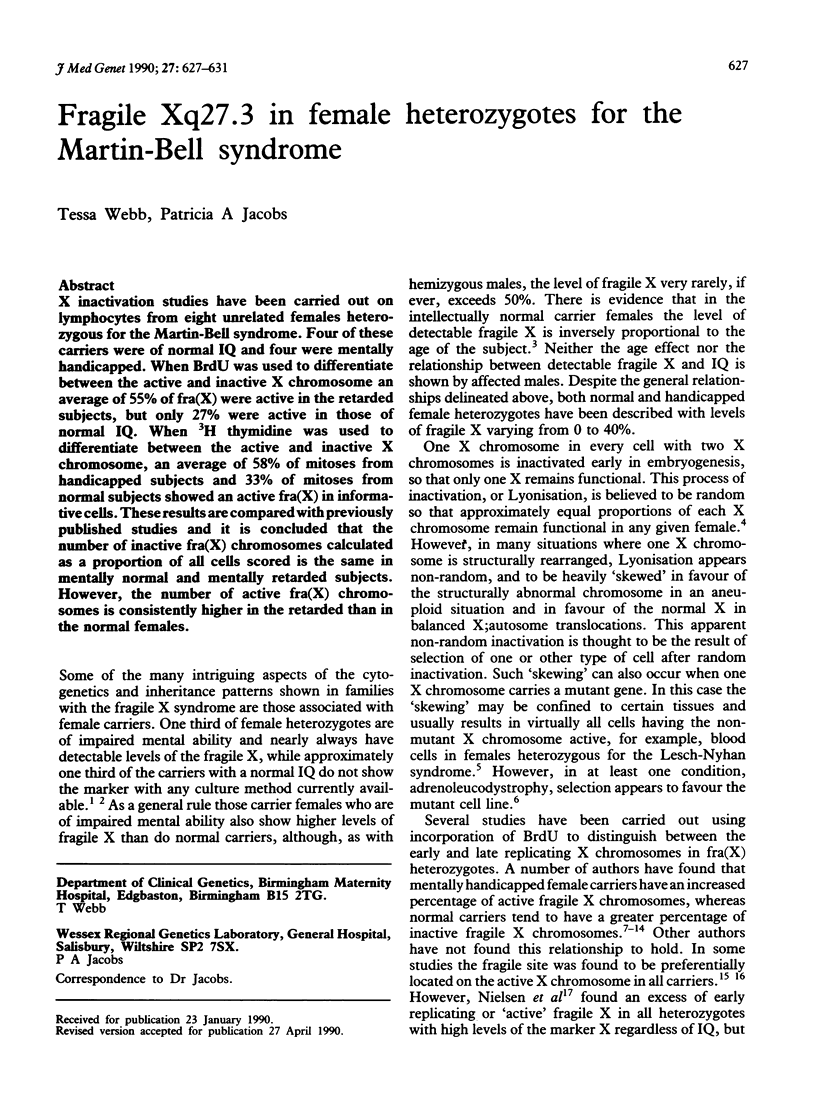
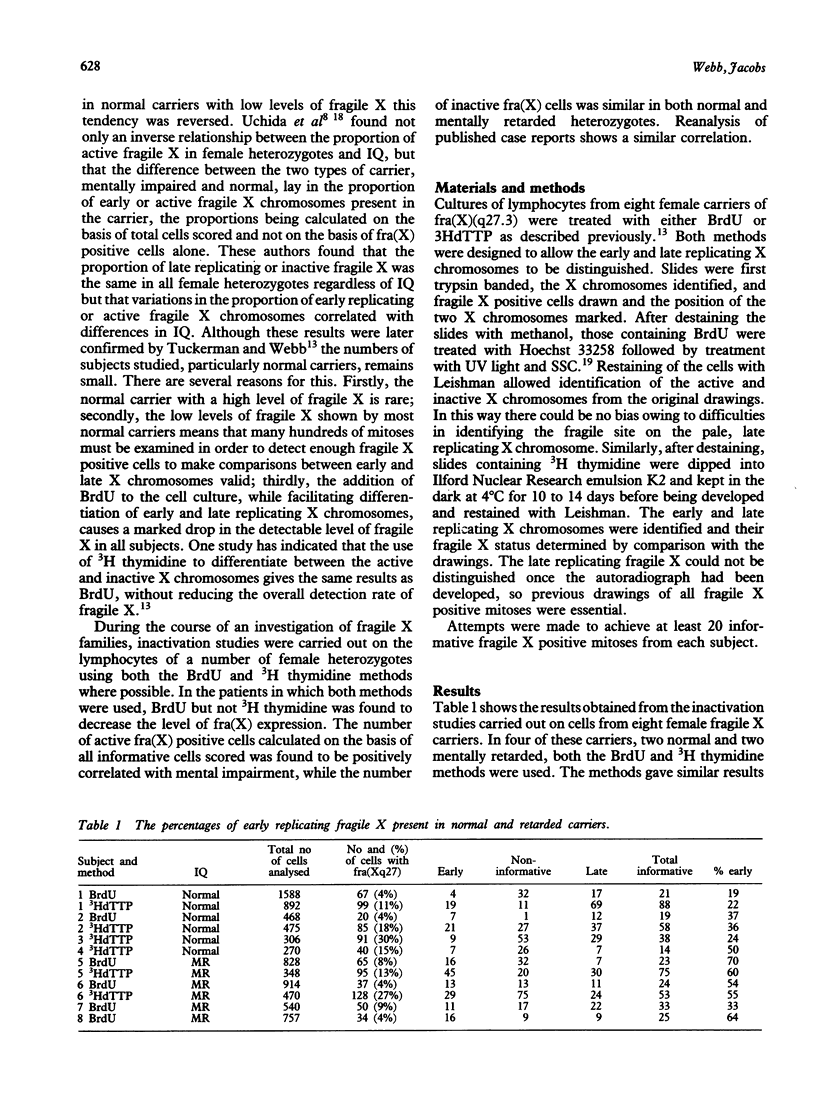
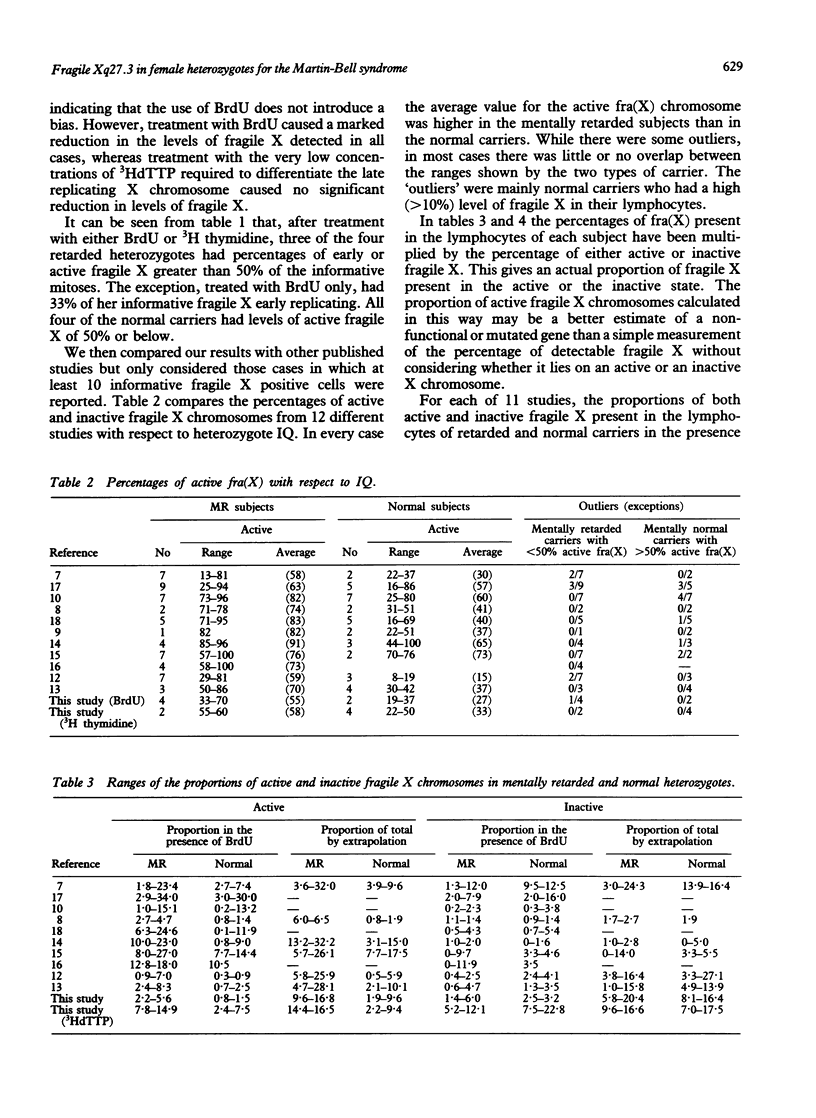
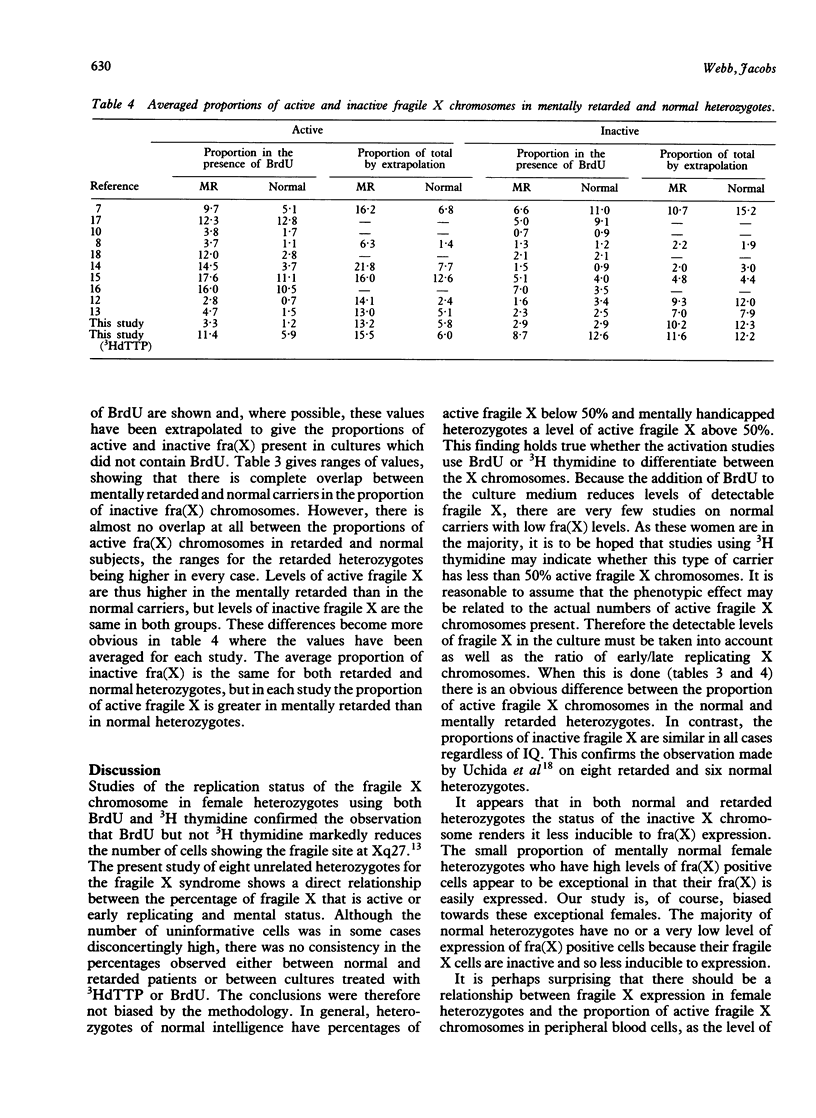
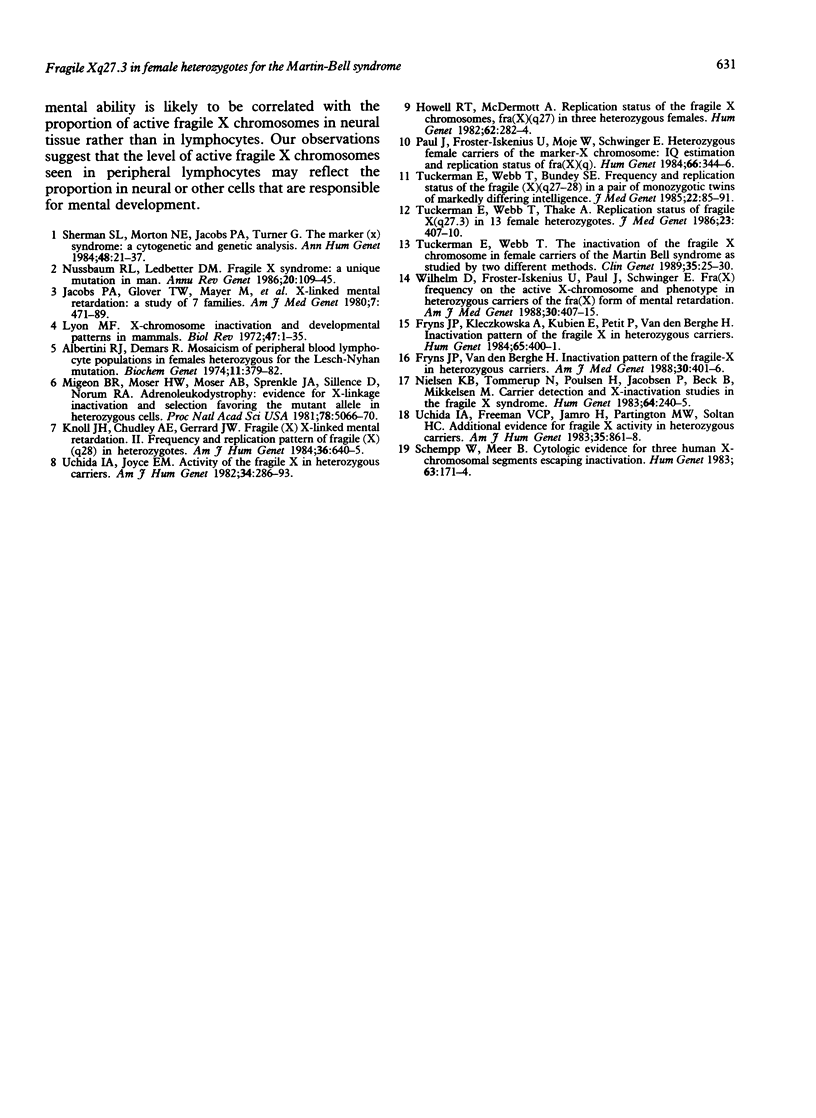
Selected References
These references are in PubMed. This may not be the complete list of references from this article.
- Fryns J. P., Kleczkowska A., Kubień E., Petit P., Van den Berghe H. Inactivation pattern of the fragile X in heterozygous carriers. Hum Genet. 1984;65(4):400–401. doi: 10.1007/BF00291567. [DOI] [PubMed] [Google Scholar]
- Fryns J. P., Van den Berghe H. Inactivation pattern of the fragile X in heterozygous carriers. Am J Med Genet. 1988 May-Jun;30(1-2):401–406. doi: 10.1002/ajmg.1320300140. [DOI] [PubMed] [Google Scholar]
- Howell R. T., McDermott A. Replication status of the fragile X chromosome, fra(X)(q27), in three heterozygous females. Hum Genet. 1982;62(3):282–284. doi: 10.1007/BF00333538. [DOI] [PubMed] [Google Scholar]
- Jacobs P. A., Glover T. W., Mayer M., Fox P., Gerrard J. W., Dunn H. G., Herbst D. S. X-linked mental retardation: a study of 7 families. Am J Med Genet. 1980;7(4):471–489. doi: 10.1002/ajmg.1320070408. [DOI] [PubMed] [Google Scholar]
- Knoll J. H., Chudley A. E., Gerrard J. W. Fragile (X) X-linked mental retardation. II. Frequency and replication pattern of fragile (X)(q28) in heterozygotes. Am J Hum Genet. 1984 May;36(3):640–645. [PMC free article] [PubMed] [Google Scholar]
- Lyon M. F. X-chromosome inactivation and developmental patterns in mammals. Biol Rev Camb Philos Soc. 1972 Jan;47(1):1–35. doi: 10.1111/j.1469-185x.1972.tb00969.x. [DOI] [PubMed] [Google Scholar]
- Migeon B. R., Moser H. W., Moser A. B., Axelman J., Sillence D., Norum R. A. Adrenoleukodystrophy: evidence for X linkage, inactivation, and selection favoring the mutant allele in heterozygous cells. Proc Natl Acad Sci U S A. 1981 Aug;78(8):5066–5070. doi: 10.1073/pnas.78.8.5066. [DOI] [PMC free article] [PubMed] [Google Scholar]
- Nielsen K. B., Tommerup N., Poulsen H., Jacobsen P., Beck B., Mikkelsen M. Carrier detection and X-inactivation studies in the fragile X syndrome. Cytogenetic studies in 63 obligate and potential carriers of the fragile X. Hum Genet. 1983;64(3):240–245. doi: 10.1007/BF00279401. [DOI] [PubMed] [Google Scholar]
- Nussbaum R. L., Ledbetter D. H. Fragile X syndrome: a unique mutation in man. Annu Rev Genet. 1986;20:109–145. doi: 10.1146/annurev.ge.20.120186.000545. [DOI] [PubMed] [Google Scholar]
- Paul J., Froster-Iskenius U., Moje W., Schwinger E. Heterozygous female carriers of the marker-X-chromosome: IQ estimation and replication status of fra(X)(q). Hum Genet. 1984;66(4):344–346. doi: 10.1007/BF00287638. [DOI] [PubMed] [Google Scholar]
- Schempp W., Meer B. Cytologic evidence for three human X-chromosomal segments escaping inactivation. Hum Genet. 1983;63(2):171–174. doi: 10.1007/BF00291539. [DOI] [PubMed] [Google Scholar]
- Sherman S. L., Morton N. E., Jacobs P. A., Turner G. The marker (X) syndrome: a cytogenetic and genetic analysis. Ann Hum Genet. 1984 Jan;48(Pt 1):21–37. doi: 10.1111/j.1469-1809.1984.tb00830.x. [DOI] [PubMed] [Google Scholar]
- Tuckerman E., Webb T., Bundey S. E. Frequency and replication status of the fragile X, fra(X)(q27-28), in a pair of monozygotic twins of markedly differing intelligence. J Med Genet. 1985 Apr;22(2):85–91. doi: 10.1136/jmg.22.2.85. [DOI] [PMC free article] [PubMed] [Google Scholar]
- Tuckerman E., Webb T., Thake A. Replication status of fragile X(q27.3) in 13 female heterozygotes. J Med Genet. 1986 Oct;23(5):407–410. doi: 10.1136/jmg.23.5.407. [DOI] [PMC free article] [PubMed] [Google Scholar]
- Tuckerman E., Webb T. The inactivation of the fragile X chromosome in female carriers of the Martin Bell syndrome as studied by two different methods. Clin Genet. 1989 Jul;36(1):25–30. doi: 10.1111/j.1399-0004.1989.tb03362.x. [DOI] [PubMed] [Google Scholar]
- Uchida I. A., Freeman V. C., Jamro H., Partington M. W., Soltan H. C. Additional evidence for fragile X activity in heterozygous carriers. Am J Hum Genet. 1983 Sep;35(5):861–868. [PMC free article] [PubMed] [Google Scholar]
- Uchida I. A., Joyce E. M. Activity of the fragile X in heterozygous carriers. Am J Hum Genet. 1982 Mar;34(2):286–293. [PMC free article] [PubMed] [Google Scholar]
- Wilhelm D., Froster-Iskenius U., Paul J., Schwinger E. Fra(X) frequency on the active X-chromosome and phenotype in heterozygous carriers of the fra(X) form of mental retardation. Am J Med Genet. 1988 May-Jun;30(1-2):407–415. doi: 10.1002/ajmg.1320300141. [DOI] [PubMed] [Google Scholar]


